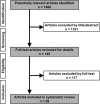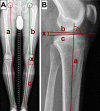The Impact of Osseous Malalignment and Realignment Procedures in Knee Ligament Surgery: A Systematic Review of the Clinical Evidence
- PMID: 28451605
- PMCID: PMC5400157
- DOI: 10.1177/2325967117697287
The Impact of Osseous Malalignment and Realignment Procedures in Knee Ligament Surgery: A Systematic Review of the Clinical Evidence
Abstract
Background: Failure rates of knee ligament surgery may be high, and the impact of osseous alignment on surgical outcome remains controversial. Basic science studies have demonstrated that osseous malalignment can negatively affect ligament strain and that realignment procedures may improve knee joint stability.
Hypothesis/purpose: The purpose of this review was to summarize the clinical evidence concerning the impact of osseous malalignment and realignment procedures in knee ligament surgery. The hypotheses were that lower extremity malalignment would be an important contributor to knee ligament surgery failure and that realignment surgery would contribute to increased knee stability and improved outcome in select cases.
Study design: Systematic review; Level of evidence, 4.
Methods: According to the PRISMA (Preferred Reporting Items for Systematic Reviews and Meta-Analyses) guidelines, a systematic electronic search of the PubMed database was performed in November 2015 to identify clinical studies investigating (A) the influence of osseous alignment on postoperative stability and/or failure rates after knee ligament surgery and (B) the impact of osseous realignment procedures in unstable knees with or without additional knee ligament surgery on postoperative knee function and stability. Methodological quality of the studies was assessed using the Oxford Centre for Evidence-Based Medicine Levels of Evidence and the Coleman Methodological Score (CMS).
Results: Of the 1466 potentially relevant articles, 28 studies fulfilled the inclusion and exclusion criteria. Average study quality was poor (CMS, 40). For part A, studies showed increased rerupture rate after anterior cruciate ligament (ACL) replacement in patients with increased tibial slope. Concerning the posterior cruciate ligament (PCL)/posterolateral corner (PLC)/lateral collateral ligament (LCL), varus malalignment was considered a significant risk factor for failure. For part B, studies showed decreased anterior tibial translation after slope-decreasing high tibial osteotomy in ACL-deficient knees. Correcting varus malalignment in PCL/PLC/LCL instability also showed increased stability and better outcomes.
Conclusion: In cases of complex knee instability, the 3-dimensional osseous alignment of the knee should be considered (eg, mechanical weightbearing line and tibial slope). In cases of failed ACL reconstruction, the tibial slope should be considered, and slope-reducing osteotomies are often helpful in the patient revised multiple times. In cases of chronic PCL and/or PLC instability, osseous correction of the varus alignment may reduce the failure rate and is often the first step in treatment. Changes in the mechanical axis should be considered in all cases of instability accompanied by early unicompartmental osteoarthritis.
Keywords: ACL revision; high tibial osteotomy; knee instability; osseous geometry; tibial slope.
Conflict of interest statement
One or more of the authors has declared the following potential conflict of interest or source of funding: T.T. is a consultant for Arthrex and Bauerfeind. J.P. is a consultant for Stryker. S.H. is a consultant for Arthrex. M.T.H. is a consultant for Depuy Synthes and Smith & Nephew; received a research grant from Mathys; and is a paid speaker for Arthrex and Zimmer. A.B.I. is a consultant for Arthrex and receives royalties from Arthrex and Arthrosurface.
Figures


Similar articles
-
Clinical Outcomes of High Tibial Osteotomy for Knee Instability: A Systematic Review.Orthop J Sports Med. 2016 Mar 7;4(3):2325967116633419. doi: 10.1177/2325967116633419. eCollection 2016 Mar. Orthop J Sports Med. 2016. PMID: 27047982 Free PMC article.
-
[Osteotomies around the knee for ligament insufficiency].Orthopade. 2017 Jul;46(7):601-609. doi: 10.1007/s00132-017-3439-x. Orthopade. 2017. PMID: 28600607 Review. German.
-
[Application of high tibial osteotomy for chronic multi-ligament knee injury associated with lower extremity malalignment].Zhongguo Xiu Fu Chong Jian Wai Ke Za Zhi. 2022 Jan 15;36(1):18-24. doi: 10.7507/1002-1892.202106025. Zhongguo Xiu Fu Chong Jian Wai Ke Za Zhi. 2022. PMID: 35038795 Free PMC article. Chinese.
-
Effect of Slope and Varus Correction High Tibial Osteotomy in the ACL-Deficient and ACL-Reconstructed Knee on Kinematics and ACL Graft Force: A Biomechanical Analysis.Am J Sports Med. 2021 Feb;49(2):410-416. doi: 10.1177/0363546520976147. Epub 2020 Dec 3. Am J Sports Med. 2021. PMID: 33270464
-
Role of high tibial osteotomy in chronic injuries of posterior cruciate ligament and posterolateral corner.J Orthop Traumatol. 2011 Mar;12(1):1-17. doi: 10.1007/s10195-010-0120-0. Epub 2010 Nov 24. J Orthop Traumatol. 2011. PMID: 21107635 Free PMC article. Review.
Cited by
-
The application of proximal tibial anterior closing wedge osteotomy in anterior cruciate ligament reconstruction.Asia Pac J Sports Med Arthrosc Rehabil Technol. 2024 Jul 17;38:1-8. doi: 10.1016/j.asmart.2024.06.001. eCollection 2024 Oct. Asia Pac J Sports Med Arthrosc Rehabil Technol. 2024. PMID: 39113923 Free PMC article.
-
Correlation of Isokinetic Testing and ACL Failure With the Short Graft Tape Suspension Technique at Six Months.Arthrosc Sports Med Rehabil. 2022 Jan 6;4(2):e585-e590. doi: 10.1016/j.asmr.2021.11.020. eCollection 2022 Apr. Arthrosc Sports Med Rehabil. 2022. PMID: 35494276 Free PMC article.
-
The Posterolateral Instability Score (PoLIS) of the knee joint: a guideline for standardized documentation, classification, and surgical decision-making.Knee Surg Sports Traumatol Arthrosc. 2021 Mar;29(3):889-899. doi: 10.1007/s00167-020-06044-y. Epub 2020 May 27. Knee Surg Sports Traumatol Arthrosc. 2021. PMID: 32458033
-
High Tibial Osteotomy for Varus Deformity of the Knee.J Am Acad Orthop Surg Glob Res Rev. 2021 Jul 9;5(7):e21.00141. doi: 10.5435/JAAOSGlobal-D-21-00141. J Am Acad Orthop Surg Glob Res Rev. 2021. PMID: 34242204 Free PMC article. Review.
-
Collateral ligament strain is linearly related to coronal lower limb alignment: A biomechanical study.Knee Surg Sports Traumatol Arthrosc. 2025 Jan;33(1):144-156. doi: 10.1002/ksa.12340. Epub 2024 Jun 27. Knee Surg Sports Traumatol Arthrosc. 2025. PMID: 38932622 Free PMC article.
References
-
- Agneskirchner JD, Hurschler C, Stukenborg-Colsman C, Imhoff AB, Lobenhoffer P. Effect of high tibial flexion osteotomy on cartilage pressure and joint kinematics: a biomechanical study in human cadaveric knees. Winner of the AGA-DonJoy Award 2004. Arch Orthop Trauma Surg. 2004;124:575–584. - PubMed
-
- Agneskirchner JD, Hurschler C, Wrann CD, Lobenhoffer P. The effects of valgus medial opening wedge high tibial osteotomy on articular cartilage pressure of the knee: a biomechanical study. Arthroscopy. 2007;23:852–861. - PubMed
-
- Amis AA. Biomechanics of high tibial osteotomy. Knee Surg Sports Traumatol Arthrosc. 2013;21:197–205. - PubMed
-
- Arthur A, LaPrade RF, Agel J. Proximal tibial opening wedge osteotomy as the initial treatment for chronic posterolateral corner deficiency in the varus knee: a prospective clinical study. Am J Sports Med. 2007;35:1844–1850. - PubMed
Publication types
LinkOut - more resources
Full Text Sources
Other Literature Sources
Medical

